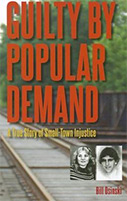Guilty By Popular Demand: A True Story of Small-Town Injustice

Author: Bill Osinski
Publisher: Kent, OH: The Kent State University Press, 2012. 179p.
Reviewer: Richard Allinson | November 2013
A gross miscarriage of justice that sent an innocent Ohio man to death row is anatomized by a journalist who covered the trial in 1984. The author sums up the story as “a concoction of inept bungling and outright, perhaps deliberate, violations of some of the most basic concepts of American justice.”
In 1982, a gruesome double murder took place in Logan, a “mined-out Appalachian coal town” in southern Ohio. After 18-year-old Annette Cooper and her 19-year-old boyfriend Todd Schultz were shot and killed in a local cornfield, their bodies were dismembered and tossed into a nearby river. The resulting community hysteria put pressure on the local police to identify a suspect quickly. Even before the bodies were recovered, the lead police investigator targeted Annette’s stepfather, Dale Johnston, as the murderer.
The prosecution’s most important evidence was a witness’s testimony that on the day of the murders he saw Johnston angrily ordering the two victims to get into his truck not far from the crime scene. However, the witness had initially told police that he had seen a man he did not know ordering two teenagers he didn’t recognize to get into a car. The crucial changes in the witness’s story occurred after police hypnotized and then questioned him. Osinski describes how the investigators’ leading questions implanted “false memories” in the witness’s mind so that he would believe that Johnston was the man he’d seen with the victims. The decision of the trial judges to allow testimony derived from this “memory-muddling” hypnosis was the most egregious of the errors cited by Ohio appellate courts in overturning Johnston’s conviction in 1988. (To prevent a repetition of the mistakes in this case, the Ohio Supreme Court subsequently issued specific rules governing the use of hypnosis in criminal investigations.)
Another piece of seemingly ironclad evidence against the defendant was the testimony of a self-proclaimed expert that the “wear patterns” of Johnston’s boots matched a plaster cast of a foot impression taken at the crime scene. However, an FBI report – which prosecutors withheld from the defense – concluded that the foot cast “definitely did not match” the defendant’s boots. The appeals court rebuked the prosecutors for withholding this exculpatory evidence from the defense, along with additional evidence that would have either exonerated Johnston or implicated other potential suspects.
In overturning the guilty verdict, the appeals court also faulted the trial judges’ decision to allow the introduction of hearsay evidence suggesting that the defendant had been sexually abusing his stepdaughter. This hearsay provided the only evidence of Johnston’s supposed motive for the killings: that he was jealous of Annette’s relationship with Todd.
The author provides a highly readable history of the Logan case, following it all the way to the convictions of the actual murderers in 2008. But comparisons to some wrongful convictions of more recent years would have helped readers assess the extent of progress since the Johnston case.
Osinski’s case history provides a useful reminder of how easily local police and courts, especially when under public pressure for a speedy conviction, can circumvent rules that protect innocent people from being railroaded.
Richard Allinson is the former editor and publisher of Criminal Justice Press.


